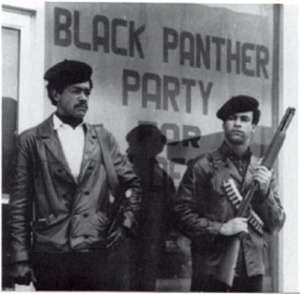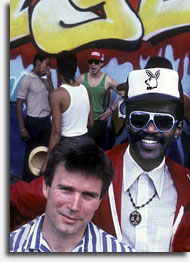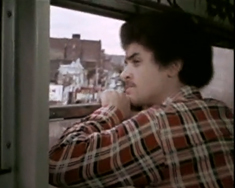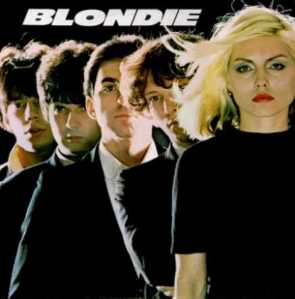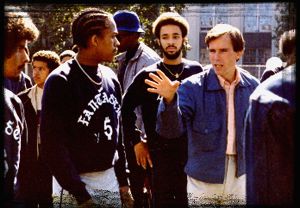Got Myself A Gun
by Bruce Banter

I would be a millionaire if I had a dollar for every time I read about a rapper being arrested on a gun charge. In today’s hip hop culture, guns are ‘fashion statements’ for the young. Especially for those projecting a thug like image. You realize its mainly about, image when you notice that the richest rap stars (Eminem, Dr. Dre, and P-Diddy) have all been arrested and charged for gun possession at the height of their career. Yes these Forbes men all have a rap sheet (no pun intended). These men can easily afford top-notch security; the type of protection equivalent to royalty and heads of countries. Once caught with a gun, the rapper will receive probation and agree not to carry it anymore because this would be a parole violation and it’s almost impossible to beat a 2nd gun charge while you are still on probation. Ironically the rapper often feels his credibility is intact just from the arrest, but the risk of jail becomes too real, to get caught again.
The majority of rappers are not rich and can’t afford professional security but since they project wealth they worry that, somebody who is as poor as they actually are, might be out to get them, so they arm themselves. Artist who don’t flaunt material possessions or feel the need to project a tough image are never in the headlines for gun possession. They may have them at home but they don’t feel a need to carry them wherever they go. So we can conclude image plays a major role.
I suspect the reason that more rap artist get in trouble with guns is part glorification and part geography. Hip-hop developed in New York and was initially an inner city phenomenon. New York and other urban centers are more restrictive about gun ownership. Primarily because places like Detroit, Cleveland, Chicago, Philadelphia etc had instances where the people revolted against their oppressive conditions and took to the streets. Historians usually refer to these instances as riots. However the point is that resistance in urban areas like the aforementioned places almost always results in “guerilla warfare”. Having to do battle up close and personal, door-to-door, shootouts in tight spaces like project buildings makes for a great equalizer, even when going up against a better-trained force. So the federal Gun Control Act of 1968 was passed as a response to racially charged revolts in major cities.
Race-based “gun control” has existed ever since the second amendment was established. Huey Newton and Bobby Seale read Robert F. Williams book “Negroes with Guns” and borrowed heavily from it while constructing the theoretical basis for the Black Panther Party for Self -Defense in September of 1966, at a library in North Oakland. The Panthers are known widely for “gun liberation” thanks to Robert Williams book, which became a bible of Black militancy. Williams book inspired them and The Black Panthers became famous with the doctrine of “Black self defense”, that the black war veteran (Marine), civil rights leader and Former NAACP Chapter leader documented as philosophy and policy.
http://www.youtube.com/watch?v=7U3spArjhUA
Williams more than documented black self-defense he practiced what he preached but gets little credit because his activities didn’t get projected via television. At the time, the Justice Department, the Federal Bureau of Investigation and local law enforcement refused to provide protection to the black community while supporting and enabling perpetrators of violence in his hometown of Monroe, North Carolina. In response, Williams organized mostly black war veterans. They noticed that when armed defense teams returned fire, the racist mobs would lose their nerve. Confirming the cowardice inherent in mob mentality. Williams strongly believed self-defense should function as a critical component in a broadly conceived strategy for liberation. Williams understood this revelation as early as the age of 21. In 1946 only a few months home from war, Williams joined the growing ranks of black vets who felt like they had not come home to “pick cotton”.
Bennie Montgomery a fellow vet and friend of Williams killed a white man in self-defense. The white man had assaulted him and tried to slit his throat because he asked for his wages at noon instead of at the end of the day. The Ku Klux Klan wanted to come to town for revenge but authorities shipped Montgomery out of town, convicted him and executed him in the gas chamber. When Montgomery’s body was shipped back to his family the Klan said his body belonged to them. They said they was going to come and take the body drag it up and down the streets and then hang and burn it. Williams and fellow vets made a defense plan at the local barbershop. When the Klan motorcade pulled up in front of the Harris Funeral Home, 40 black men leveled their rifles, taking aim at the line of cars. Not a shot was fired; the Klansmen simply weighed their chances and drove away. That was one of the 1st incidents that got them realizing about resistance in groups. Their would be many more incidents of self defense and finally ten years later Williams would organize a permanent defense group, an “organized militia” for self defense. The NAACP at the time did not believe in self-defense and would vilify him and reduce his chapter temporarily to just him. It would not matter though, he was effective in self-defense and black people throughout the country were becoming more aware and ready to follow him. The best way for many blacks to really understand self defense tactics would be from Williams, so he wrote “Negroes with Guns”, and in later years, groups like the Black Panther Party helped make self defense a national issue.
The Black Panther Party quickly captured the attention of the national media when they marched on the California State capitol on May 2nd, 1967. In the book “Seize The Time” Huey Newton says, “We’re going to the Capitol. Mulford’s there, and they’re trying to pass a law against our guns, and we’re going to the Capitol steps. We’re going to take the best Panthers we got and we’re going to the Capitol steps with our guns and forces, loaded down to the gills. And we’re going to read a message to the world, because the press is always up there. They’ll listen to the message, and they’ll probably blast it all across this country. I know they’ll blast it all the way across California. We’ve got to get a message over to the people.” The message was self- defense and Huey was right the world got a visual message that was powerful and planned. Huey told a fellow panther. “Call the television stations and tell them we’re the Black Panthers,” Huey Newton had instructed. “We’re coming from Oakland, we’ve got our leather jackets on, we ‘ve got our rifles, and we’re going to walk into the legislature with guns. See what happens.” What happened was eventful on two fronts. First – the carefully orchestrated public display attracted international media attention on the local and national levels, capturing the imagination of everybody. Second – J. Edgar Hoover and the FBI got both, pissed off and frightened. Hoover described the Panthers as “the greatest threat to the internal security of the country” and in November 1968 ordered the FBI to employ “hard-hitting counter-intelligence measures to cripple the Black Panthers”. (These COINTELPRO operations are still at work today disguised under different names.) As history goes, Hoover was largely successful.
 Black Self defense sort of dissipated from the public once the Panthers were infiltrated. When the movie Panther debuted in 1995 Black people stood up and cheered during this scene depicting black men with guns parading through the state capitol. To us this was classic defiance. Apparently not much had changed in opinions from 3 decades prior. In Watts whereby the play called “If We Must Live” (based on Negroes with Guns book) was performed in theatres it was always to standing ovations for half a year. Almost 10 years have passed since Panther debuted and how much you want to bet blacks would still stand and applaud when images of black men with guns in self-defense are presented. To our community standing up is heroic, to others its scary as 9/11. On the other hand when the black community hears of black men being busted for gun possession they realize that this activity is not synonymous with Williams or Newton’s heroic history. Outside of Tupac, who shot 2 cops (though they were off-duty) you would be hard pressed to find a rapper defending himself from white aggression, even in their videos they practice running from it. The guns they have are intended for aggression within their own communities. It’s obvious to me that this is a political decision.
Black Self defense sort of dissipated from the public once the Panthers were infiltrated. When the movie Panther debuted in 1995 Black people stood up and cheered during this scene depicting black men with guns parading through the state capitol. To us this was classic defiance. Apparently not much had changed in opinions from 3 decades prior. In Watts whereby the play called “If We Must Live” (based on Negroes with Guns book) was performed in theatres it was always to standing ovations for half a year. Almost 10 years have passed since Panther debuted and how much you want to bet blacks would still stand and applaud when images of black men with guns in self-defense are presented. To our community standing up is heroic, to others its scary as 9/11. On the other hand when the black community hears of black men being busted for gun possession they realize that this activity is not synonymous with Williams or Newton’s heroic history. Outside of Tupac, who shot 2 cops (though they were off-duty) you would be hard pressed to find a rapper defending himself from white aggression, even in their videos they practice running from it. The guns they have are intended for aggression within their own communities. It’s obvious to me that this is a political decision.
History proves that “who gets to have a gun” is a very political topic. Michael Moore offers a nice historical anecdote in his documentary movie “Bowling for Columbine”. Some say he politicized the gun issue too much by injecting race into the discussion but in all honesty you can’t talk about guns in America objectively and not discuss race. Prior to FBI COINTELPRO guns had primarily been used by white men for aggression and black men for protection against aggressors. Today the only difference in usage of these diametrically opposed racial groups is political. White men with guns are a political movement. 90% of white men with guns voted for Bush. Black men with guns are not a collective but individuals either wanting them for self-defense or aggression. Both white and black gun owners offer ambiguous language in the Constitution and Second Amendment as a reason they should have guns. In my opinion it is not hard to tell who wants a gun for self-defense and who wants a gun for “incidental aggression”. All you need to do is observe the patron who wants the AK-47 (affectionately called the street sweepers) he’s either part of a white anti-government militia or he’s part of a white anti-everything militia. Active gang members of all ethnicities also want these automatic weapons but their chances of getting them legally is slim to none.
I could cite you numerous reports on guns and public safety that show that crime levels, particularly those involving guns, are extremely high, and that gun ownership in this new era is largely ineffective for self-defense. They would even reveal that guns pose a very serious threat to public safety, and that the widespread ownership of guns does not increase public safety, and may well reduce it significantly. Further, while owning a gun may make you feel safer; it does not necessarily translate into an actual increase in security.” However, I would probably be wasting my time because the political climate surrounding guns is so intense that studies have been done of studies, that have been done about studies, on the issue. Many of the basic statistics about guns are in wide disagreement with each other and opinions largely depend on which sources you use or if you already have your mind made up. I don’t have my mind made up, either way, but while I contemplate the history of guns in the black community, I am going to watch some Black Caesar and fill out the proper paper work so that I can get myself a gun! – Nuff said
